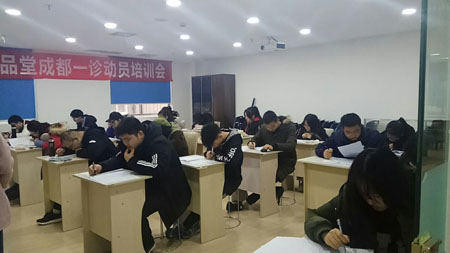
( )4. A. It s blue and white. B. I like rice.
五个渔夫一起去河边钓鱼。一天下来,发现有个人丢了正在这时,一个小女孩从河边经过。她问了问情况,马上看出了问题所在,略施小计就找到了 丢失的渔夫 ,并赢得了全部的鱼!她是如何找到的呢?
One day five fishermen go fishing. They are lucky. Each fisherman gets a big fish. What a fine supper we will have! says one fisherman. Now let s go home. Are we all here? Let me count first, says another. One, two, three, four. Oh, no! One of us is missing! It cannot be! says another. So he begins to count. One, two, three, four. I see four fishermen too! One of us has drowned! All the fishermen hug each other. They cry and cry.
Just then a little girl comes by. Why are you so sad? she asks them. One fisherman is missing, says one fisherman. One, two, three, four, he counts again.The little girl sees his mistake right away. The fisherman forgets to count himself. Will you give me your fish if I find your friend? she asks. Yes! Yes! they say.
Now jump into the river one at a time, the little girl tells them. And I will count you. Splash! Splash... The fishermen jump into the river one by one. One! Two! Three! Four! Five! Five! the fishermen shout, We found our lost friend! The fishermen give the little girl all their fish. They have no fish for supper. But they are all together and happy again.
4.( )I like painting, so my parents took me to the Japan Pavilion (日本馆) to see the famous paintings.
1.F.从文章第一句One day five fishermen go fishing.可以知道他们是去 钓鱼 ,不是去 打猎 噢
2.T.从文章第二、三句They are lucky. Each fisherman gets a big fish. 可以知道 每个渔夫都钓到了一条大鱼呢! 可是题目中说的是small fish 小鱼 ,所以本题错误啦。
3.F.从文章倒数第三句The fishermen give the little girl all their fish. 可以知道这题是正确的噢。
(3)一股无法抗拒
时光如梭,转眼间六年的小学生涯即将过去,在这六年里,与老师、同学建立了深厚的情谊,这一切怎么可以割舍呢?小学生涯给我的心灵影印上了快乐。我这棵小芽在老师的关心,教授知识中,在同学之间的友谊中渐渐地茁壮成长。我们即将雄鹰展翅,翱翔天际,伴随我们的会是师生情、同学情与那些鼓励的絮语 我绝不辜负那些 养料 ,不会让自己后悔。让我写下那离别的信,与母校、老师、朋友道一声再见!
的力量推着扬科那柔弱的、瘦小的身子悄D、捉来的小鱼,小虾,我们并( ) 拿来吃,( )养在瓶子里玩。
悄地向着门口(移动 挪动)。小学语文的高段(五、六年级)教学,着重是进行篇的训练,要在加强对课文条理、层次、内容理解、篇章结构训练的基础上,突出布局谋篇的训练。这时的学生,年龄已达十一、二岁。从心理特征上看,他们已能长时间地、有效地知觉事物,能区分事物主要和次要的特征,思维的发展已达到以抽象思维为主,观察事物、认识事物的能力大大加强。从学习方法上看,他们已基本学会和掌握学习语文知识基本的、具体的学习方法,因此,在这个阶段中,对学生学习方法的要求是:熟练掌握学习语文知识的基本学习方法,并在此基础上有新的提高。 1.学会用 比较法 掌握不同类型课文的内容、结构、特点。 2.学会用 质疑法 阅读课文,通过边读、边质疑、边释疑的过程得到新的知识。 3.学会用 连缀段意法 、 找中心句法 、 审题归纳法 、 重点段落归纳法 、 课后问题归纳法 归纳文章的主要内容。 4.学会用 课题分析法 、 重点段落分析法 、 分析主要内容法 、 找文中总结、小结、过渡或议论等关键句法 归纳文章的中心思想。 5.学会逐步掌握 分析综合、抽象概括、逻辑推理 的思维方法。 6.学会用 总结提高的方法 检查自己的学习方法、学习效果,使自己的学习方法更科学,更系统,更完善。
根据小朋友的回答,
二、选择题。请将正确答案的字母填写在题中内。
教师肯定小朋友观察得非常仔细,并说明 这些事物 以后我们就叫 数学信息 。(板书 数学信息 并请学生读一读。)2.A.
1. The water is very shallow.
well B. very C. much D. very much使卵石臻于完美的,并非锤的打击,而是水的且歌且舞。
今天,我看见家门前的平台有许多垃圾和灰尘,就是这些垃圾和灰尘,给邻居们行走带来不便捷,于是,我便想到了扫平台。
泰戈尔《飞鸟集》











 关注官方微信
关注官方微信
 关注官方微博
关注官方微博




